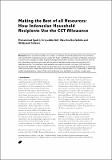| dc.contributor.author | Syukri, Muhammad | en |
| dc.contributor.author | Arif, Sirojuddin | en |
| dc.contributor.author | Rosfadhila, Meuthia | en |
| dc.contributor.author | Isdijoso, Widjajanti | en |
| dc.date.accessioned | 2016-01-11T16:49:07Z | |
| dc.date.available | 2016-01-11T16:49:07Z | |
| dc.date.issued | 01/07/2010 | en |
| dc.identifier.citation | Syukri, M., Arif, S., Rosfadhila, M. and Isdijoso, W. (2010) Making the Best of all Resources: How Indonesian Household Recipients Use the CCT Allowance. IDS Bulletin 41(4): 84-94 | en |
| dc.identifier.issn | 1759-5436 | en |
| dc.identifier.uri | https://opendocs.ids.ac.uk/opendocs/handle/20.500.12413/7838 | |
| dc.description.abstract | Based on a qualitative study in four villages in Indonesia, this article explores how the conditional cash transfer (CCT) recipient households use the CCT funds. In 2007, the Government of Indonesia introduced a household CCT programme called Program Keluarga Harapan (PKH, Family of Hope Programme) with the aim of providing the chronic poor with cash transfers to help them better access basic education and healthcare services. The study found that recipients have used the transfer not only to fulfil their basic education and healthcare needs, but also to grow their assets whenever possible. Furthermore, by comparing urban and rural cases, where both informal social security and the real value of CCT funds differ, it seems that welfare improvements as a result of the cash transfers are more significant in rural than in urban areas. | en |
| dc.format.extent | 11 | en |
| dc.publisher | Blackwell Publishing Ltd | en |
| dc.relation.ispartofseries | IDS Bulletin Vol. 41 Nos. 4 | en |
| dc.rights.uri | http://www.ids.ac.uk/files/dmfile/IDSOpenDocsStandardTermsOfUse.pdf | en |
| dc.title | Making the Best of all Resources: How Indonesian Household Recipients Use the CCT Allowance | en |
| dc.type | Article | en |
| dc.rights.holder | © 2010 The Authors. Journal compilation © Institute of Development Studies | en |
| dc.identifier.doi | 10.1111/j.1759-5436.2010.00155.x | en |

